Market Structure Analysis of KFC and Oporto Fast Food Companies
VerifiedAdded on 2022/11/23
|15
|4321
|364
AI Summary
This report analyzes the market structure of KFC and Oporto fast food companies and compares them with close competing firms in the same industry. It uses economic theories to evaluate the market and suggests growth strategies, pricing and non-pricing strategies for the companies.
Contribute Materials
Your contribution can guide someone’s learning journey. Share your
documents today.
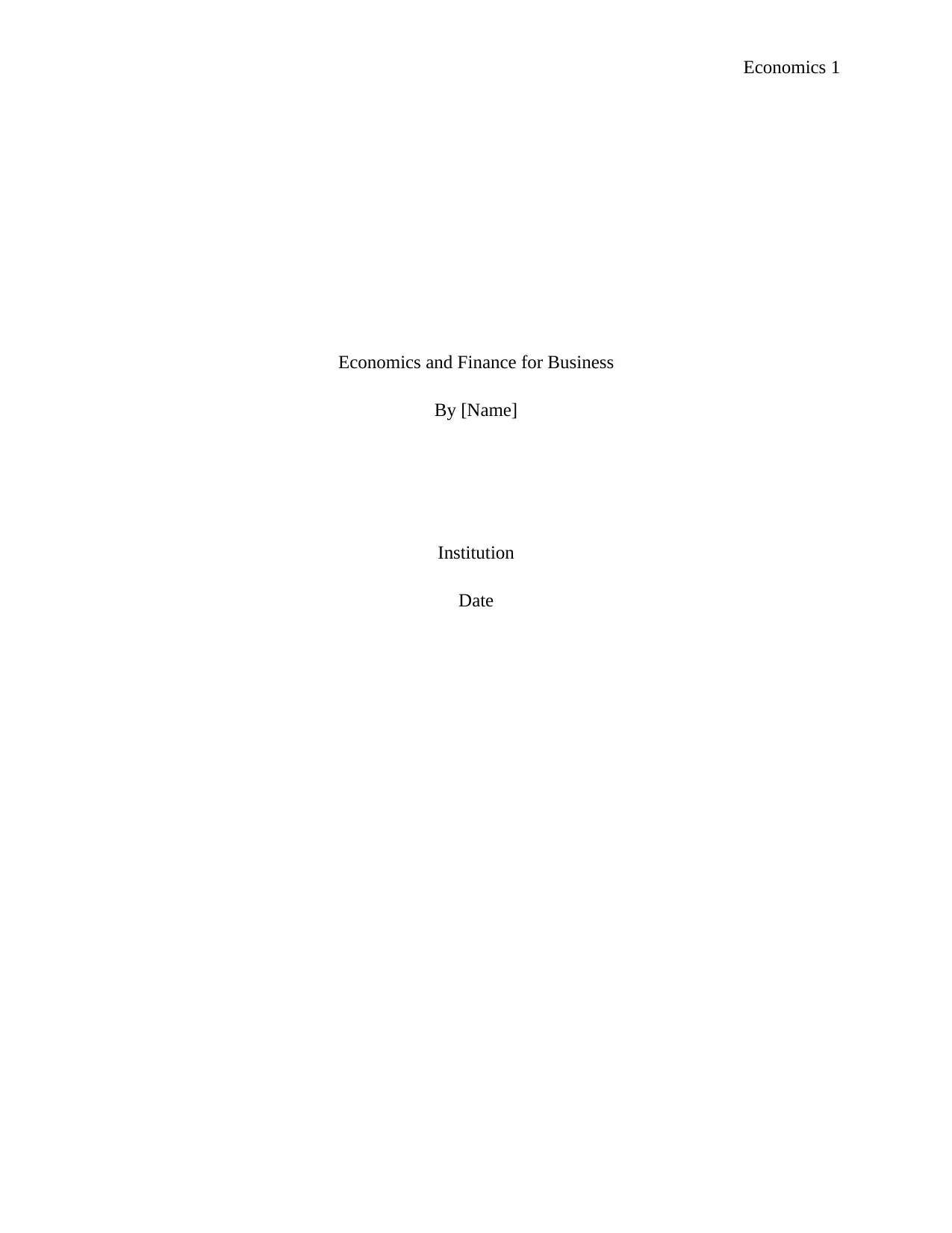
Economics 1
Economics and Finance for Business
By [Name]
Institution
Date
Economics and Finance for Business
By [Name]
Institution
Date
Secure Best Marks with AI Grader
Need help grading? Try our AI Grader for instant feedback on your assignments.
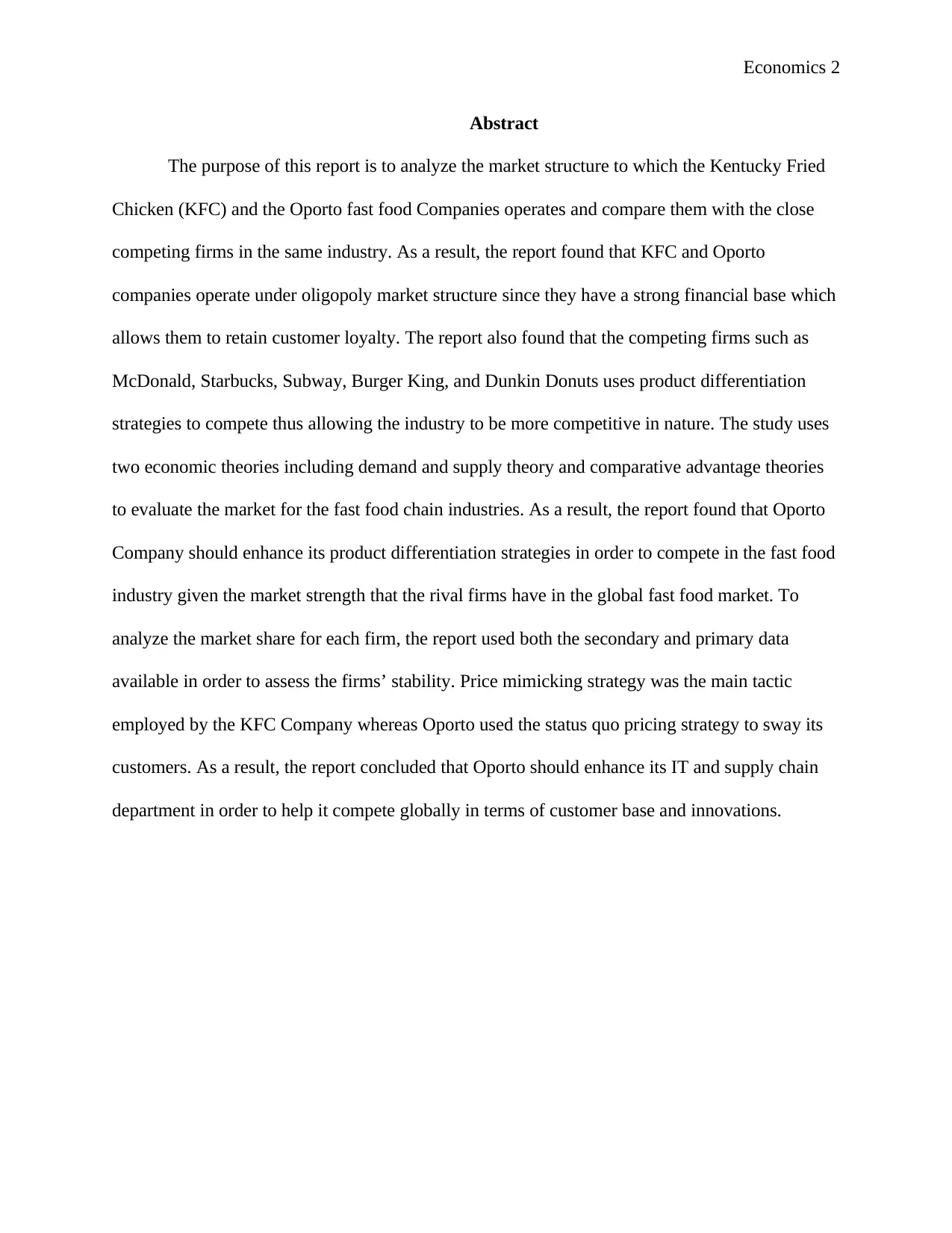
Economics 2
Abstract
The purpose of this report is to analyze the market structure to which the Kentucky Fried
Chicken (KFC) and the Oporto fast food Companies operates and compare them with the close
competing firms in the same industry. As a result, the report found that KFC and Oporto
companies operate under oligopoly market structure since they have a strong financial base which
allows them to retain customer loyalty. The report also found that the competing firms such as
McDonald, Starbucks, Subway, Burger King, and Dunkin Donuts uses product differentiation
strategies to compete thus allowing the industry to be more competitive in nature. The study uses
two economic theories including demand and supply theory and comparative advantage theories
to evaluate the market for the fast food chain industries. As a result, the report found that Oporto
Company should enhance its product differentiation strategies in order to compete in the fast food
industry given the market strength that the rival firms have in the global fast food market. To
analyze the market share for each firm, the report used both the secondary and primary data
available in order to assess the firms’ stability. Price mimicking strategy was the main tactic
employed by the KFC Company whereas Oporto used the status quo pricing strategy to sway its
customers. As a result, the report concluded that Oporto should enhance its IT and supply chain
department in order to help it compete globally in terms of customer base and innovations.
Abstract
The purpose of this report is to analyze the market structure to which the Kentucky Fried
Chicken (KFC) and the Oporto fast food Companies operates and compare them with the close
competing firms in the same industry. As a result, the report found that KFC and Oporto
companies operate under oligopoly market structure since they have a strong financial base which
allows them to retain customer loyalty. The report also found that the competing firms such as
McDonald, Starbucks, Subway, Burger King, and Dunkin Donuts uses product differentiation
strategies to compete thus allowing the industry to be more competitive in nature. The study uses
two economic theories including demand and supply theory and comparative advantage theories
to evaluate the market for the fast food chain industries. As a result, the report found that Oporto
Company should enhance its product differentiation strategies in order to compete in the fast food
industry given the market strength that the rival firms have in the global fast food market. To
analyze the market share for each firm, the report used both the secondary and primary data
available in order to assess the firms’ stability. Price mimicking strategy was the main tactic
employed by the KFC Company whereas Oporto used the status quo pricing strategy to sway its
customers. As a result, the report concluded that Oporto should enhance its IT and supply chain
department in order to help it compete globally in terms of customer base and innovations.

Economics 3
Introduction
Classification of market structure solemnly depends on the pricing strategies and degree of
competitiveness. However, there are four types of market which includes perfectly competitive
market, monopoly, monopolistic, and oligopoly (Von, 2010). The differences in these markets
depend with how firms operate i.e. in perfect competition market, firms are regarded as price
takers while in monopolistic market, and firms are recognized with their abilities to have market
powers. In contrary, oligopoly markets is where few firms with capital advantages can be price
makers while in monopoly, just one firm is price market and it dictates the market structure for
the sales of goods and services (Janssen & Roy, 2010).
This report will therefore examine the type of market structure that KFC Company and
Oporto franchise operates in. Both companies have enjoyed economies of scales in terms of
growth and technological advancement thus making them to be regarded as rival firms in the first
food industry. The report will use both the primary and secondary data to ascertain some facts
pertaining to market trend, pricing and turnover for both companies in order to come up with a
suitable conclusion on how to help either the companies, or just one of them grow in these
crowded market.
KFC and Oporto Fast Food Companies
KFC is regarded as one of the largest first food distributor with a strong capital base both
in the USA, Europe, Asia, and Africa (Waweru, 2016). The company has been operating in this
industry since 1930 but managed to enter Australia in 1968 where it has managed to carry
successful business operations in terms of profit and stability. The first outlet of the Kentucky
Fried Chicken (KFC) was first opened in Guildford in Sydney with approximated number of
Introduction
Classification of market structure solemnly depends on the pricing strategies and degree of
competitiveness. However, there are four types of market which includes perfectly competitive
market, monopoly, monopolistic, and oligopoly (Von, 2010). The differences in these markets
depend with how firms operate i.e. in perfect competition market, firms are regarded as price
takers while in monopolistic market, and firms are recognized with their abilities to have market
powers. In contrary, oligopoly markets is where few firms with capital advantages can be price
makers while in monopoly, just one firm is price market and it dictates the market structure for
the sales of goods and services (Janssen & Roy, 2010).
This report will therefore examine the type of market structure that KFC Company and
Oporto franchise operates in. Both companies have enjoyed economies of scales in terms of
growth and technological advancement thus making them to be regarded as rival firms in the first
food industry. The report will use both the primary and secondary data to ascertain some facts
pertaining to market trend, pricing and turnover for both companies in order to come up with a
suitable conclusion on how to help either the companies, or just one of them grow in these
crowded market.
KFC and Oporto Fast Food Companies
KFC is regarded as one of the largest first food distributor with a strong capital base both
in the USA, Europe, Asia, and Africa (Waweru, 2016). The company has been operating in this
industry since 1930 but managed to enter Australia in 1968 where it has managed to carry
successful business operations in terms of profit and stability. The first outlet of the Kentucky
Fried Chicken (KFC) was first opened in Guildford in Sydney with approximated number of
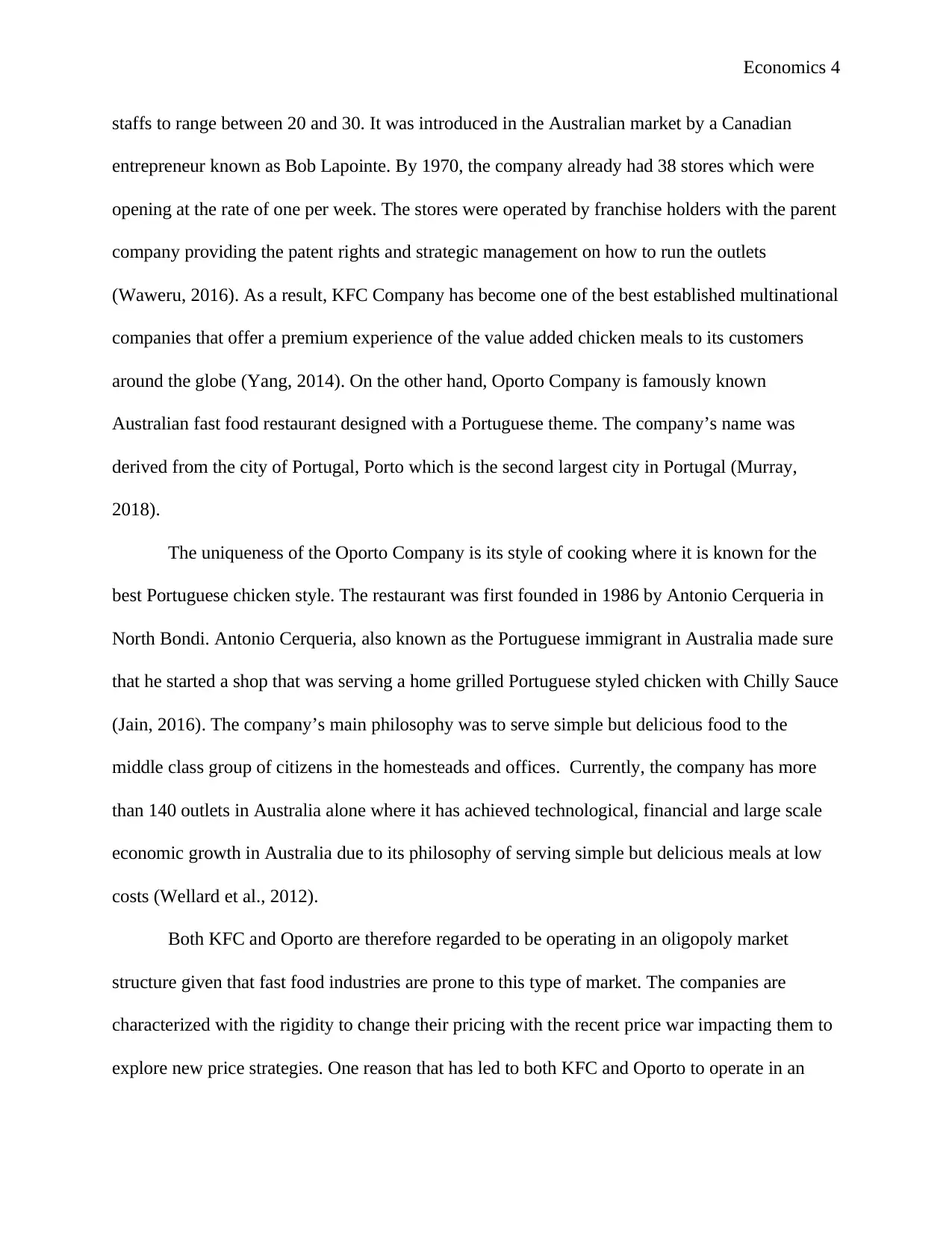
Economics 4
staffs to range between 20 and 30. It was introduced in the Australian market by a Canadian
entrepreneur known as Bob Lapointe. By 1970, the company already had 38 stores which were
opening at the rate of one per week. The stores were operated by franchise holders with the parent
company providing the patent rights and strategic management on how to run the outlets
(Waweru, 2016). As a result, KFC Company has become one of the best established multinational
companies that offer a premium experience of the value added chicken meals to its customers
around the globe (Yang, 2014). On the other hand, Oporto Company is famously known
Australian fast food restaurant designed with a Portuguese theme. The company’s name was
derived from the city of Portugal, Porto which is the second largest city in Portugal (Murray,
2018).
The uniqueness of the Oporto Company is its style of cooking where it is known for the
best Portuguese chicken style. The restaurant was first founded in 1986 by Antonio Cerqueria in
North Bondi. Antonio Cerqueria, also known as the Portuguese immigrant in Australia made sure
that he started a shop that was serving a home grilled Portuguese styled chicken with Chilly Sauce
(Jain, 2016). The company’s main philosophy was to serve simple but delicious food to the
middle class group of citizens in the homesteads and offices. Currently, the company has more
than 140 outlets in Australia alone where it has achieved technological, financial and large scale
economic growth in Australia due to its philosophy of serving simple but delicious meals at low
costs (Wellard et al., 2012).
Both KFC and Oporto are therefore regarded to be operating in an oligopoly market
structure given that fast food industries are prone to this type of market. The companies are
characterized with the rigidity to change their pricing with the recent price war impacting them to
explore new price strategies. One reason that has led to both KFC and Oporto to operate in an
staffs to range between 20 and 30. It was introduced in the Australian market by a Canadian
entrepreneur known as Bob Lapointe. By 1970, the company already had 38 stores which were
opening at the rate of one per week. The stores were operated by franchise holders with the parent
company providing the patent rights and strategic management on how to run the outlets
(Waweru, 2016). As a result, KFC Company has become one of the best established multinational
companies that offer a premium experience of the value added chicken meals to its customers
around the globe (Yang, 2014). On the other hand, Oporto Company is famously known
Australian fast food restaurant designed with a Portuguese theme. The company’s name was
derived from the city of Portugal, Porto which is the second largest city in Portugal (Murray,
2018).
The uniqueness of the Oporto Company is its style of cooking where it is known for the
best Portuguese chicken style. The restaurant was first founded in 1986 by Antonio Cerqueria in
North Bondi. Antonio Cerqueria, also known as the Portuguese immigrant in Australia made sure
that he started a shop that was serving a home grilled Portuguese styled chicken with Chilly Sauce
(Jain, 2016). The company’s main philosophy was to serve simple but delicious food to the
middle class group of citizens in the homesteads and offices. Currently, the company has more
than 140 outlets in Australia alone where it has achieved technological, financial and large scale
economic growth in Australia due to its philosophy of serving simple but delicious meals at low
costs (Wellard et al., 2012).
Both KFC and Oporto are therefore regarded to be operating in an oligopoly market
structure given that fast food industries are prone to this type of market. The companies are
characterized with the rigidity to change their pricing with the recent price war impacting them to
explore new price strategies. One reason that has led to both KFC and Oporto to operate in an
Secure Best Marks with AI Grader
Need help grading? Try our AI Grader for instant feedback on your assignments.
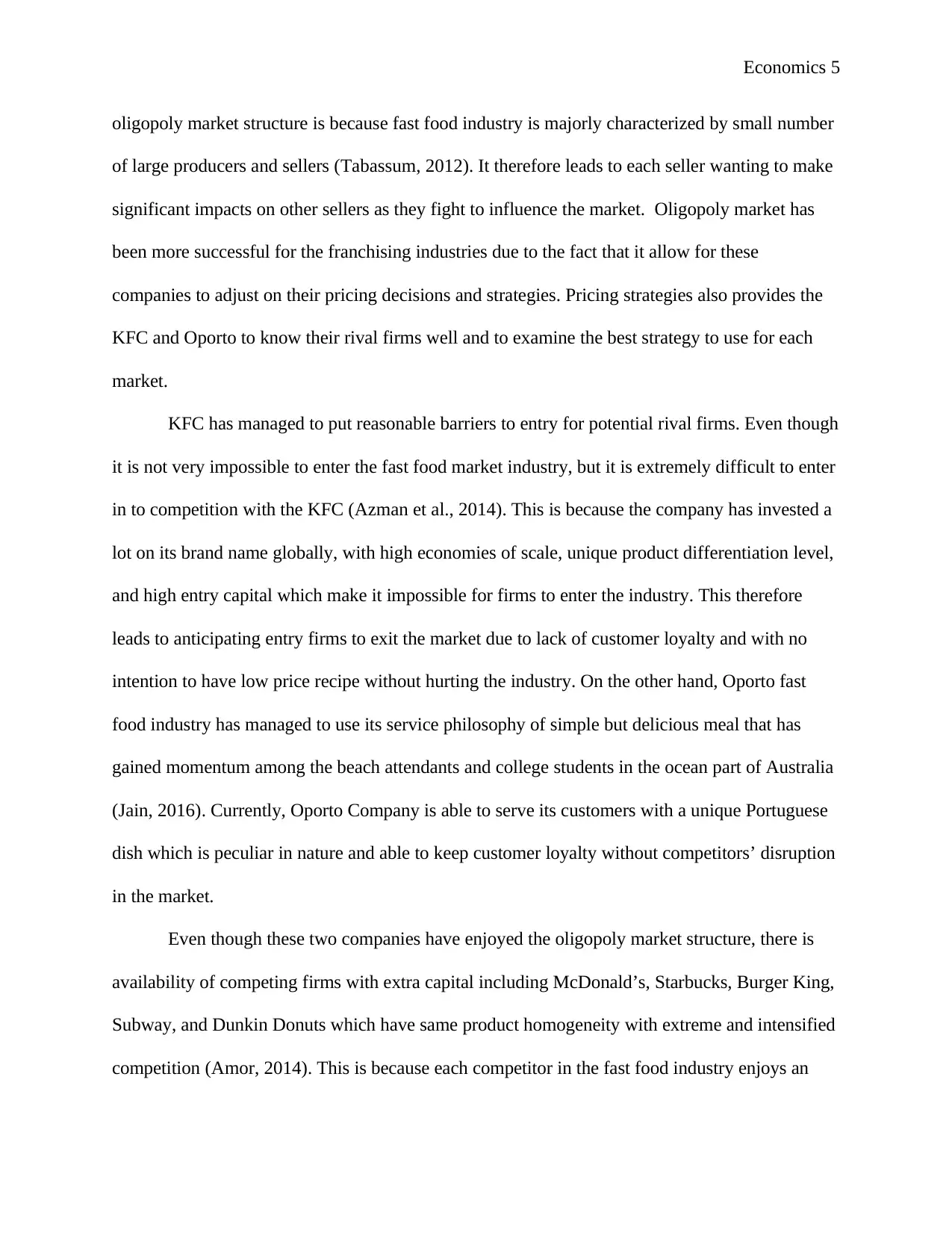
Economics 5
oligopoly market structure is because fast food industry is majorly characterized by small number
of large producers and sellers (Tabassum, 2012). It therefore leads to each seller wanting to make
significant impacts on other sellers as they fight to influence the market. Oligopoly market has
been more successful for the franchising industries due to the fact that it allow for these
companies to adjust on their pricing decisions and strategies. Pricing strategies also provides the
KFC and Oporto to know their rival firms well and to examine the best strategy to use for each
market.
KFC has managed to put reasonable barriers to entry for potential rival firms. Even though
it is not very impossible to enter the fast food market industry, but it is extremely difficult to enter
in to competition with the KFC (Azman et al., 2014). This is because the company has invested a
lot on its brand name globally, with high economies of scale, unique product differentiation level,
and high entry capital which make it impossible for firms to enter the industry. This therefore
leads to anticipating entry firms to exit the market due to lack of customer loyalty and with no
intention to have low price recipe without hurting the industry. On the other hand, Oporto fast
food industry has managed to use its service philosophy of simple but delicious meal that has
gained momentum among the beach attendants and college students in the ocean part of Australia
(Jain, 2016). Currently, Oporto Company is able to serve its customers with a unique Portuguese
dish which is peculiar in nature and able to keep customer loyalty without competitors’ disruption
in the market.
Even though these two companies have enjoyed the oligopoly market structure, there is
availability of competing firms with extra capital including McDonald’s, Starbucks, Burger King,
Subway, and Dunkin Donuts which have same product homogeneity with extreme and intensified
competition (Amor, 2014). This is because each competitor in the fast food industry enjoys an
oligopoly market structure is because fast food industry is majorly characterized by small number
of large producers and sellers (Tabassum, 2012). It therefore leads to each seller wanting to make
significant impacts on other sellers as they fight to influence the market. Oligopoly market has
been more successful for the franchising industries due to the fact that it allow for these
companies to adjust on their pricing decisions and strategies. Pricing strategies also provides the
KFC and Oporto to know their rival firms well and to examine the best strategy to use for each
market.
KFC has managed to put reasonable barriers to entry for potential rival firms. Even though
it is not very impossible to enter the fast food market industry, but it is extremely difficult to enter
in to competition with the KFC (Azman et al., 2014). This is because the company has invested a
lot on its brand name globally, with high economies of scale, unique product differentiation level,
and high entry capital which make it impossible for firms to enter the industry. This therefore
leads to anticipating entry firms to exit the market due to lack of customer loyalty and with no
intention to have low price recipe without hurting the industry. On the other hand, Oporto fast
food industry has managed to use its service philosophy of simple but delicious meal that has
gained momentum among the beach attendants and college students in the ocean part of Australia
(Jain, 2016). Currently, Oporto Company is able to serve its customers with a unique Portuguese
dish which is peculiar in nature and able to keep customer loyalty without competitors’ disruption
in the market.
Even though these two companies have enjoyed the oligopoly market structure, there is
availability of competing firms with extra capital including McDonald’s, Starbucks, Burger King,
Subway, and Dunkin Donuts which have same product homogeneity with extreme and intensified
competition (Amor, 2014). This is because each competitor in the fast food industry enjoys an
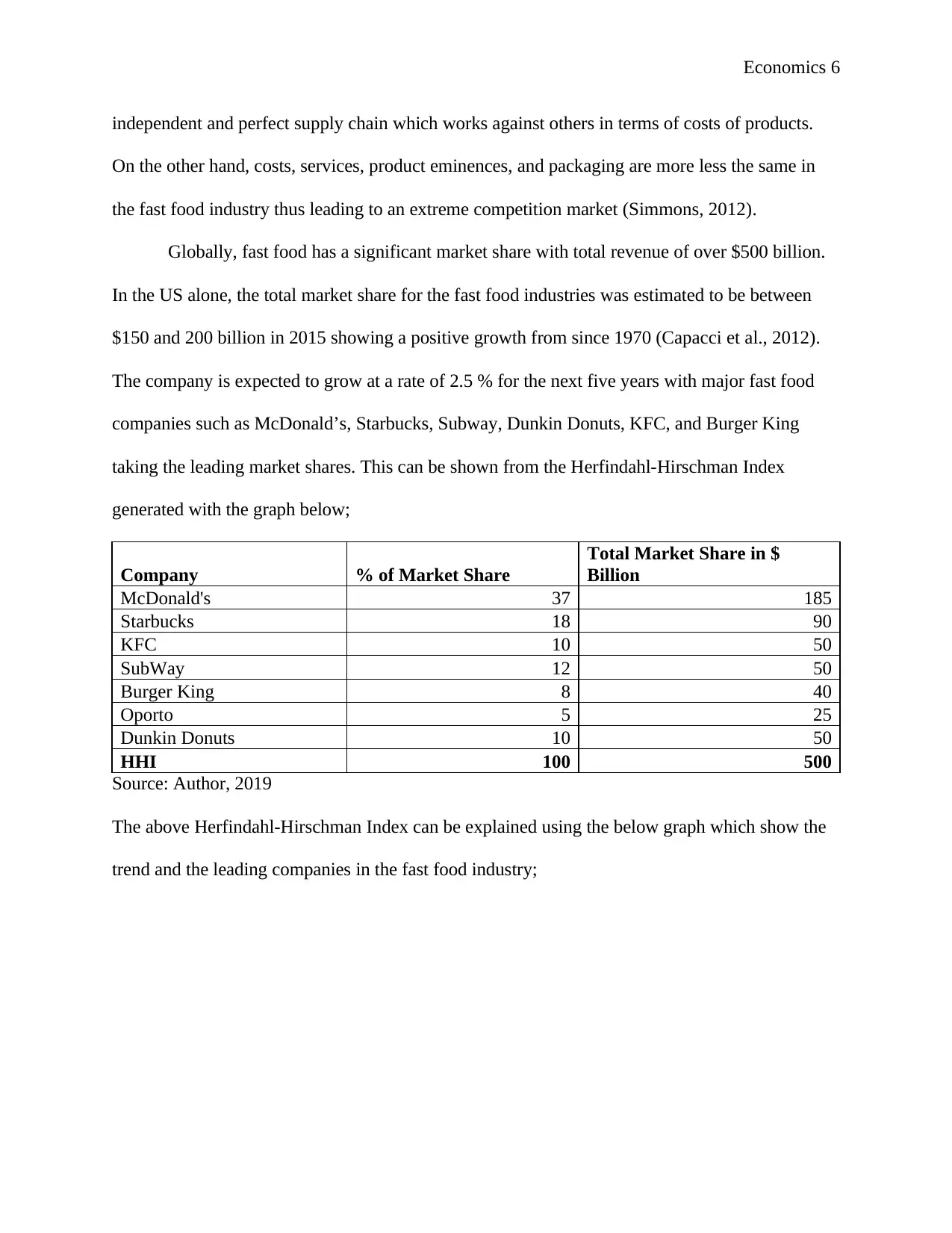
Economics 6
independent and perfect supply chain which works against others in terms of costs of products.
On the other hand, costs, services, product eminences, and packaging are more less the same in
the fast food industry thus leading to an extreme competition market (Simmons, 2012).
Globally, fast food has a significant market share with total revenue of over $500 billion.
In the US alone, the total market share for the fast food industries was estimated to be between
$150 and 200 billion in 2015 showing a positive growth from since 1970 (Capacci et al., 2012).
The company is expected to grow at a rate of 2.5 % for the next five years with major fast food
companies such as McDonald’s, Starbucks, Subway, Dunkin Donuts, KFC, and Burger King
taking the leading market shares. This can be shown from the Herfindahl-Hirschman Index
generated with the graph below;
Company % of Market Share
Total Market Share in $
Billion
McDonald's 37 185
Starbucks 18 90
KFC 10 50
SubWay 12 50
Burger King 8 40
Oporto 5 25
Dunkin Donuts 10 50
HHI 100 500
Source: Author, 2019
The above Herfindahl-Hirschman Index can be explained using the below graph which show the
trend and the leading companies in the fast food industry;
independent and perfect supply chain which works against others in terms of costs of products.
On the other hand, costs, services, product eminences, and packaging are more less the same in
the fast food industry thus leading to an extreme competition market (Simmons, 2012).
Globally, fast food has a significant market share with total revenue of over $500 billion.
In the US alone, the total market share for the fast food industries was estimated to be between
$150 and 200 billion in 2015 showing a positive growth from since 1970 (Capacci et al., 2012).
The company is expected to grow at a rate of 2.5 % for the next five years with major fast food
companies such as McDonald’s, Starbucks, Subway, Dunkin Donuts, KFC, and Burger King
taking the leading market shares. This can be shown from the Herfindahl-Hirschman Index
generated with the graph below;
Company % of Market Share
Total Market Share in $
Billion
McDonald's 37 185
Starbucks 18 90
KFC 10 50
SubWay 12 50
Burger King 8 40
Oporto 5 25
Dunkin Donuts 10 50
HHI 100 500
Source: Author, 2019
The above Herfindahl-Hirschman Index can be explained using the below graph which show the
trend and the leading companies in the fast food industry;
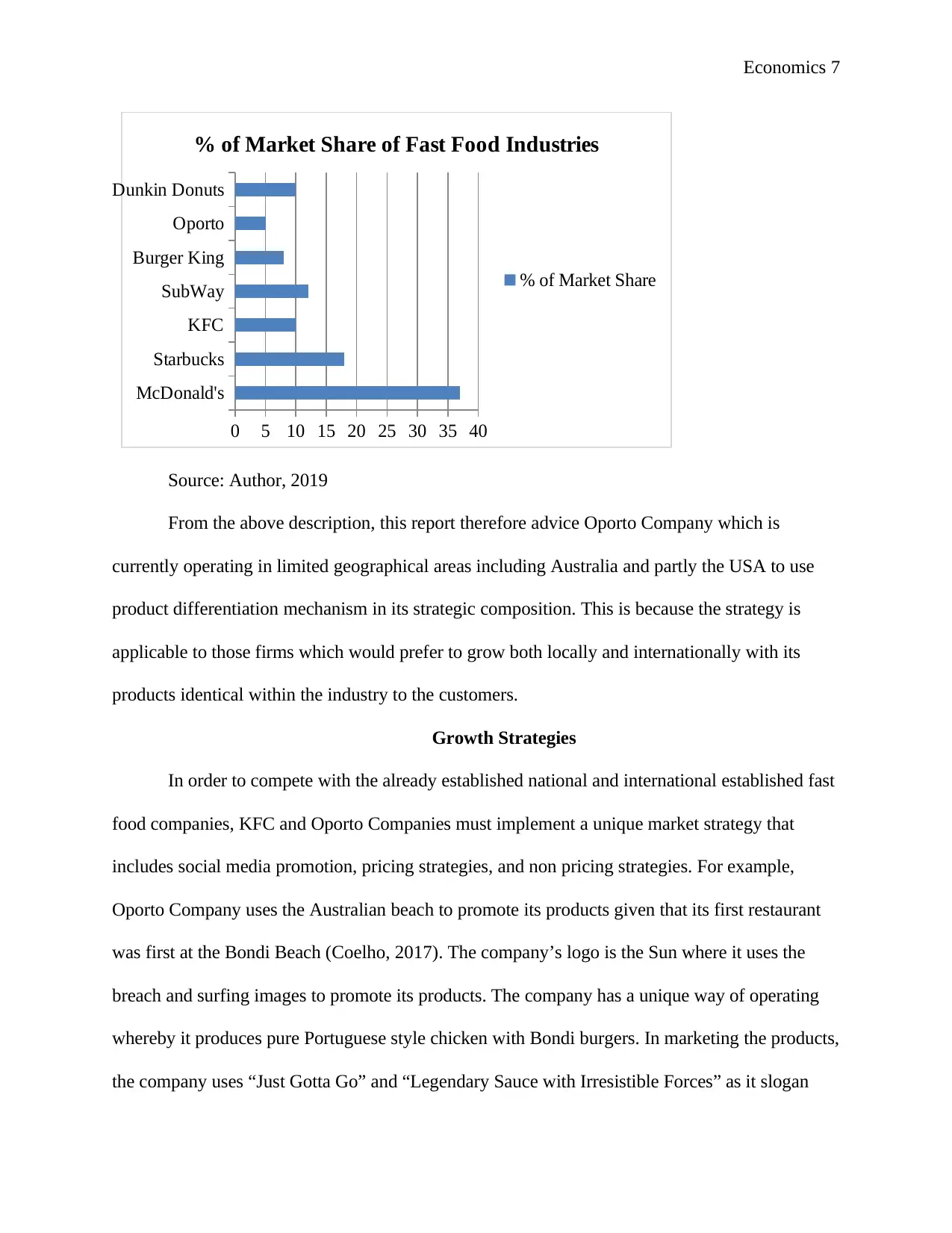
Economics 7
McDonald's
Starbucks
KFC
SubWay
Burger King
Oporto
Dunkin Donuts
0 5 10 15 20 25 30 35 40
% of Market Share of Fast Food Industries
% of Market Share
Source: Author, 2019
From the above description, this report therefore advice Oporto Company which is
currently operating in limited geographical areas including Australia and partly the USA to use
product differentiation mechanism in its strategic composition. This is because the strategy is
applicable to those firms which would prefer to grow both locally and internationally with its
products identical within the industry to the customers.
Growth Strategies
In order to compete with the already established national and international established fast
food companies, KFC and Oporto Companies must implement a unique market strategy that
includes social media promotion, pricing strategies, and non pricing strategies. For example,
Oporto Company uses the Australian beach to promote its products given that its first restaurant
was first at the Bondi Beach (Coelho, 2017). The company’s logo is the Sun where it uses the
breach and surfing images to promote its products. The company has a unique way of operating
whereby it produces pure Portuguese style chicken with Bondi burgers. In marketing the products,
the company uses “Just Gotta Go” and “Legendary Sauce with Irresistible Forces” as it slogan
McDonald's
Starbucks
KFC
SubWay
Burger King
Oporto
Dunkin Donuts
0 5 10 15 20 25 30 35 40
% of Market Share of Fast Food Industries
% of Market Share
Source: Author, 2019
From the above description, this report therefore advice Oporto Company which is
currently operating in limited geographical areas including Australia and partly the USA to use
product differentiation mechanism in its strategic composition. This is because the strategy is
applicable to those firms which would prefer to grow both locally and internationally with its
products identical within the industry to the customers.
Growth Strategies
In order to compete with the already established national and international established fast
food companies, KFC and Oporto Companies must implement a unique market strategy that
includes social media promotion, pricing strategies, and non pricing strategies. For example,
Oporto Company uses the Australian beach to promote its products given that its first restaurant
was first at the Bondi Beach (Coelho, 2017). The company’s logo is the Sun where it uses the
breach and surfing images to promote its products. The company has a unique way of operating
whereby it produces pure Portuguese style chicken with Bondi burgers. In marketing the products,
the company uses “Just Gotta Go” and “Legendary Sauce with Irresistible Forces” as it slogan
Paraphrase This Document
Need a fresh take? Get an instant paraphrase of this document with our AI Paraphraser
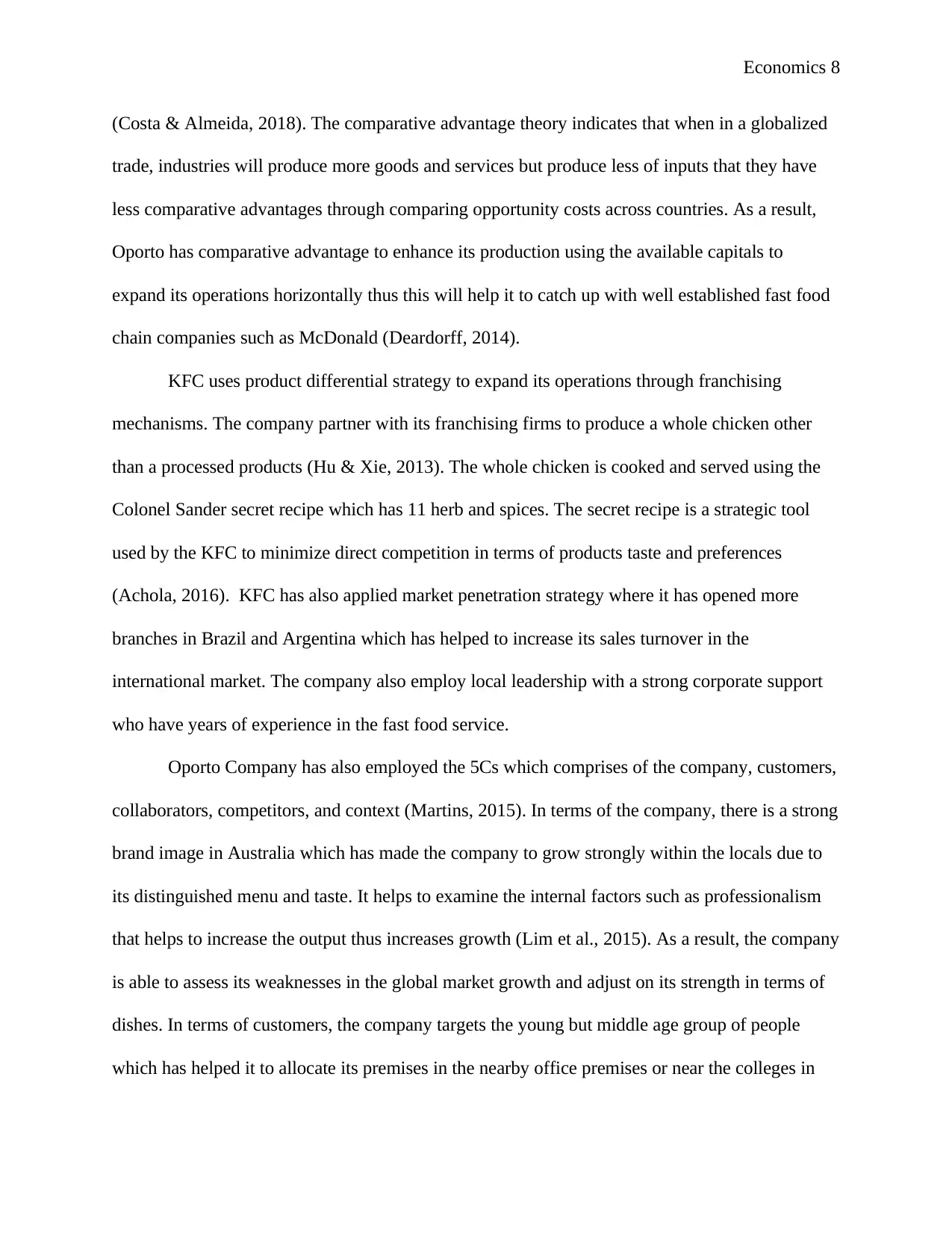
Economics 8
(Costa & Almeida, 2018). The comparative advantage theory indicates that when in a globalized
trade, industries will produce more goods and services but produce less of inputs that they have
less comparative advantages through comparing opportunity costs across countries. As a result,
Oporto has comparative advantage to enhance its production using the available capitals to
expand its operations horizontally thus this will help it to catch up with well established fast food
chain companies such as McDonald (Deardorff, 2014).
KFC uses product differential strategy to expand its operations through franchising
mechanisms. The company partner with its franchising firms to produce a whole chicken other
than a processed products (Hu & Xie, 2013). The whole chicken is cooked and served using the
Colonel Sander secret recipe which has 11 herb and spices. The secret recipe is a strategic tool
used by the KFC to minimize direct competition in terms of products taste and preferences
(Achola, 2016). KFC has also applied market penetration strategy where it has opened more
branches in Brazil and Argentina which has helped to increase its sales turnover in the
international market. The company also employ local leadership with a strong corporate support
who have years of experience in the fast food service.
Oporto Company has also employed the 5Cs which comprises of the company, customers,
collaborators, competitors, and context (Martins, 2015). In terms of the company, there is a strong
brand image in Australia which has made the company to grow strongly within the locals due to
its distinguished menu and taste. It helps to examine the internal factors such as professionalism
that helps to increase the output thus increases growth (Lim et al., 2015). As a result, the company
is able to assess its weaknesses in the global market growth and adjust on its strength in terms of
dishes. In terms of customers, the company targets the young but middle age group of people
which has helped it to allocate its premises in the nearby office premises or near the colleges in
(Costa & Almeida, 2018). The comparative advantage theory indicates that when in a globalized
trade, industries will produce more goods and services but produce less of inputs that they have
less comparative advantages through comparing opportunity costs across countries. As a result,
Oporto has comparative advantage to enhance its production using the available capitals to
expand its operations horizontally thus this will help it to catch up with well established fast food
chain companies such as McDonald (Deardorff, 2014).
KFC uses product differential strategy to expand its operations through franchising
mechanisms. The company partner with its franchising firms to produce a whole chicken other
than a processed products (Hu & Xie, 2013). The whole chicken is cooked and served using the
Colonel Sander secret recipe which has 11 herb and spices. The secret recipe is a strategic tool
used by the KFC to minimize direct competition in terms of products taste and preferences
(Achola, 2016). KFC has also applied market penetration strategy where it has opened more
branches in Brazil and Argentina which has helped to increase its sales turnover in the
international market. The company also employ local leadership with a strong corporate support
who have years of experience in the fast food service.
Oporto Company has also employed the 5Cs which comprises of the company, customers,
collaborators, competitors, and context (Martins, 2015). In terms of the company, there is a strong
brand image in Australia which has made the company to grow strongly within the locals due to
its distinguished menu and taste. It helps to examine the internal factors such as professionalism
that helps to increase the output thus increases growth (Lim et al., 2015). As a result, the company
is able to assess its weaknesses in the global market growth and adjust on its strength in terms of
dishes. In terms of customers, the company targets the young but middle age group of people
which has helped it to allocate its premises in the nearby office premises or near the colleges in
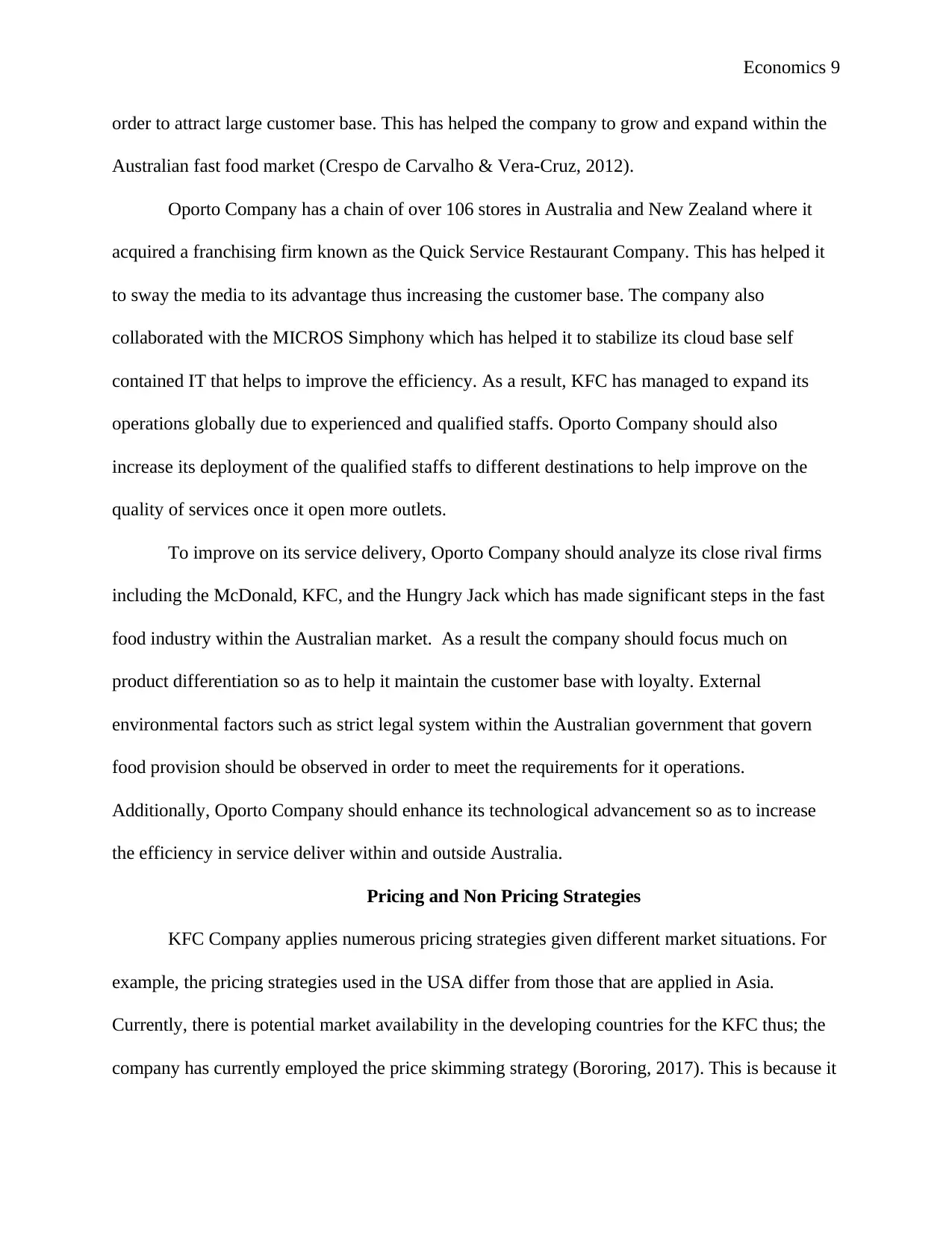
Economics 9
order to attract large customer base. This has helped the company to grow and expand within the
Australian fast food market (Crespo de Carvalho & Vera-Cruz, 2012).
Oporto Company has a chain of over 106 stores in Australia and New Zealand where it
acquired a franchising firm known as the Quick Service Restaurant Company. This has helped it
to sway the media to its advantage thus increasing the customer base. The company also
collaborated with the MICROS Simphony which has helped it to stabilize its cloud base self
contained IT that helps to improve the efficiency. As a result, KFC has managed to expand its
operations globally due to experienced and qualified staffs. Oporto Company should also
increase its deployment of the qualified staffs to different destinations to help improve on the
quality of services once it open more outlets.
To improve on its service delivery, Oporto Company should analyze its close rival firms
including the McDonald, KFC, and the Hungry Jack which has made significant steps in the fast
food industry within the Australian market. As a result the company should focus much on
product differentiation so as to help it maintain the customer base with loyalty. External
environmental factors such as strict legal system within the Australian government that govern
food provision should be observed in order to meet the requirements for it operations.
Additionally, Oporto Company should enhance its technological advancement so as to increase
the efficiency in service deliver within and outside Australia.
Pricing and Non Pricing Strategies
KFC Company applies numerous pricing strategies given different market situations. For
example, the pricing strategies used in the USA differ from those that are applied in Asia.
Currently, there is potential market availability in the developing countries for the KFC thus; the
company has currently employed the price skimming strategy (Bororing, 2017). This is because it
order to attract large customer base. This has helped the company to grow and expand within the
Australian fast food market (Crespo de Carvalho & Vera-Cruz, 2012).
Oporto Company has a chain of over 106 stores in Australia and New Zealand where it
acquired a franchising firm known as the Quick Service Restaurant Company. This has helped it
to sway the media to its advantage thus increasing the customer base. The company also
collaborated with the MICROS Simphony which has helped it to stabilize its cloud base self
contained IT that helps to improve the efficiency. As a result, KFC has managed to expand its
operations globally due to experienced and qualified staffs. Oporto Company should also
increase its deployment of the qualified staffs to different destinations to help improve on the
quality of services once it open more outlets.
To improve on its service delivery, Oporto Company should analyze its close rival firms
including the McDonald, KFC, and the Hungry Jack which has made significant steps in the fast
food industry within the Australian market. As a result the company should focus much on
product differentiation so as to help it maintain the customer base with loyalty. External
environmental factors such as strict legal system within the Australian government that govern
food provision should be observed in order to meet the requirements for it operations.
Additionally, Oporto Company should enhance its technological advancement so as to increase
the efficiency in service deliver within and outside Australia.
Pricing and Non Pricing Strategies
KFC Company applies numerous pricing strategies given different market situations. For
example, the pricing strategies used in the USA differ from those that are applied in Asia.
Currently, there is potential market availability in the developing countries for the KFC thus; the
company has currently employed the price skimming strategy (Bororing, 2017). This is because it
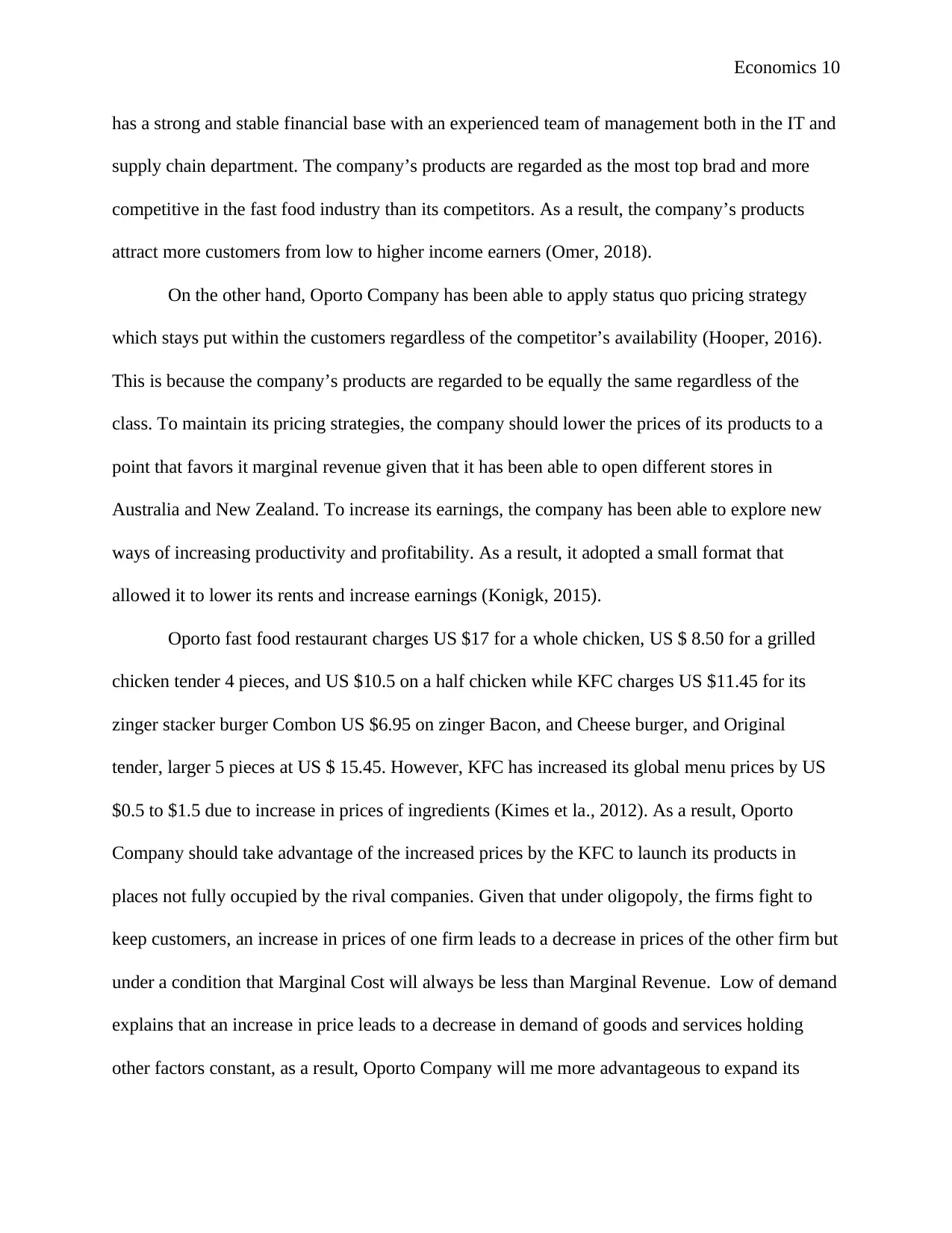
Economics 10
has a strong and stable financial base with an experienced team of management both in the IT and
supply chain department. The company’s products are regarded as the most top brad and more
competitive in the fast food industry than its competitors. As a result, the company’s products
attract more customers from low to higher income earners (Omer, 2018).
On the other hand, Oporto Company has been able to apply status quo pricing strategy
which stays put within the customers regardless of the competitor’s availability (Hooper, 2016).
This is because the company’s products are regarded to be equally the same regardless of the
class. To maintain its pricing strategies, the company should lower the prices of its products to a
point that favors it marginal revenue given that it has been able to open different stores in
Australia and New Zealand. To increase its earnings, the company has been able to explore new
ways of increasing productivity and profitability. As a result, it adopted a small format that
allowed it to lower its rents and increase earnings (Konigk, 2015).
Oporto fast food restaurant charges US $17 for a whole chicken, US $ 8.50 for a grilled
chicken tender 4 pieces, and US $10.5 on a half chicken while KFC charges US $11.45 for its
zinger stacker burger Combon US $6.95 on zinger Bacon, and Cheese burger, and Original
tender, larger 5 pieces at US $ 15.45. However, KFC has increased its global menu prices by US
$0.5 to $1.5 due to increase in prices of ingredients (Kimes et la., 2012). As a result, Oporto
Company should take advantage of the increased prices by the KFC to launch its products in
places not fully occupied by the rival companies. Given that under oligopoly, the firms fight to
keep customers, an increase in prices of one firm leads to a decrease in prices of the other firm but
under a condition that Marginal Cost will always be less than Marginal Revenue. Low of demand
explains that an increase in price leads to a decrease in demand of goods and services holding
other factors constant, as a result, Oporto Company will me more advantageous to expand its
has a strong and stable financial base with an experienced team of management both in the IT and
supply chain department. The company’s products are regarded as the most top brad and more
competitive in the fast food industry than its competitors. As a result, the company’s products
attract more customers from low to higher income earners (Omer, 2018).
On the other hand, Oporto Company has been able to apply status quo pricing strategy
which stays put within the customers regardless of the competitor’s availability (Hooper, 2016).
This is because the company’s products are regarded to be equally the same regardless of the
class. To maintain its pricing strategies, the company should lower the prices of its products to a
point that favors it marginal revenue given that it has been able to open different stores in
Australia and New Zealand. To increase its earnings, the company has been able to explore new
ways of increasing productivity and profitability. As a result, it adopted a small format that
allowed it to lower its rents and increase earnings (Konigk, 2015).
Oporto fast food restaurant charges US $17 for a whole chicken, US $ 8.50 for a grilled
chicken tender 4 pieces, and US $10.5 on a half chicken while KFC charges US $11.45 for its
zinger stacker burger Combon US $6.95 on zinger Bacon, and Cheese burger, and Original
tender, larger 5 pieces at US $ 15.45. However, KFC has increased its global menu prices by US
$0.5 to $1.5 due to increase in prices of ingredients (Kimes et la., 2012). As a result, Oporto
Company should take advantage of the increased prices by the KFC to launch its products in
places not fully occupied by the rival companies. Given that under oligopoly, the firms fight to
keep customers, an increase in prices of one firm leads to a decrease in prices of the other firm but
under a condition that Marginal Cost will always be less than Marginal Revenue. Low of demand
explains that an increase in price leads to a decrease in demand of goods and services holding
other factors constant, as a result, Oporto Company will me more advantageous to expand its
Secure Best Marks with AI Grader
Need help grading? Try our AI Grader for instant feedback on your assignments.
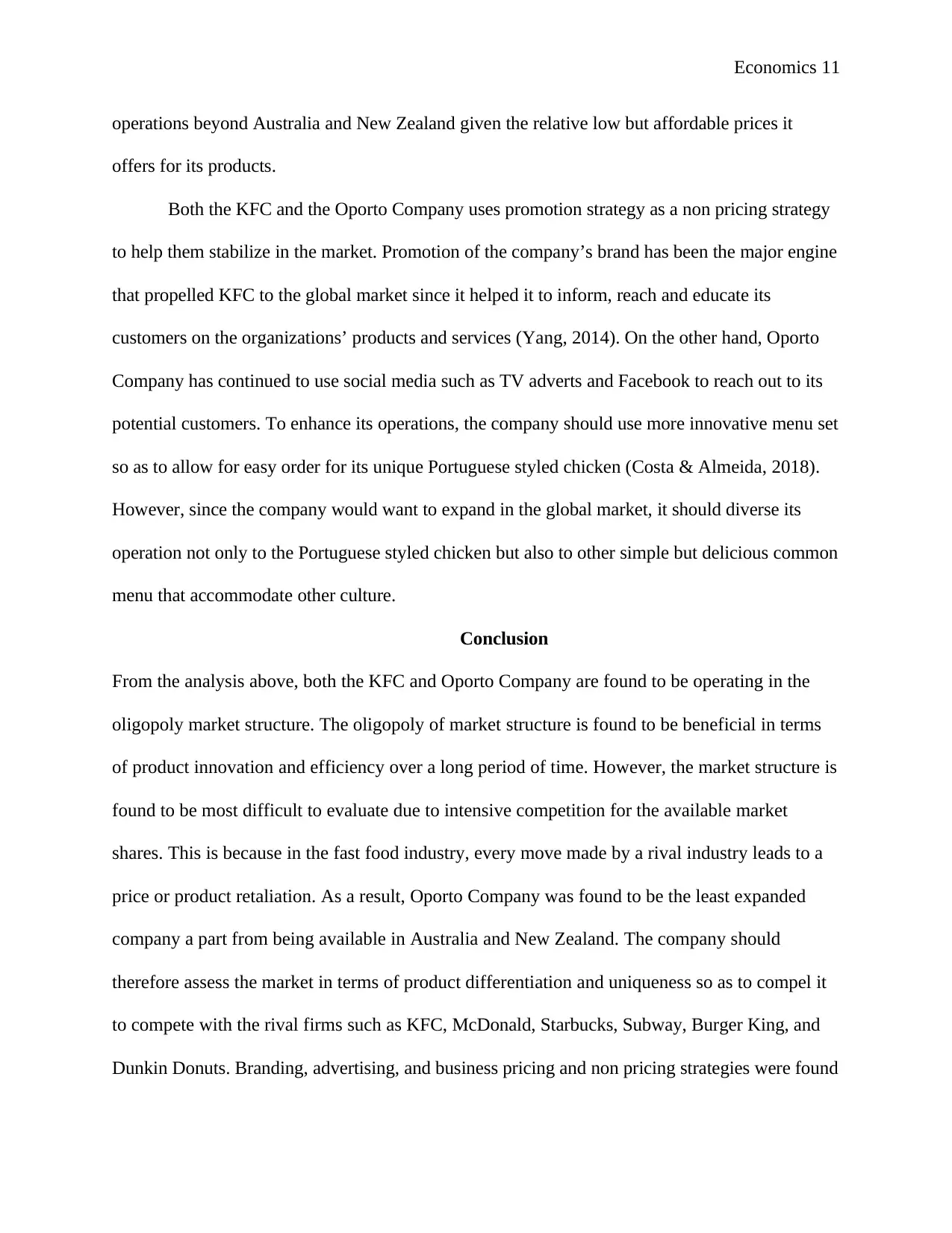
Economics 11
operations beyond Australia and New Zealand given the relative low but affordable prices it
offers for its products.
Both the KFC and the Oporto Company uses promotion strategy as a non pricing strategy
to help them stabilize in the market. Promotion of the company’s brand has been the major engine
that propelled KFC to the global market since it helped it to inform, reach and educate its
customers on the organizations’ products and services (Yang, 2014). On the other hand, Oporto
Company has continued to use social media such as TV adverts and Facebook to reach out to its
potential customers. To enhance its operations, the company should use more innovative menu set
so as to allow for easy order for its unique Portuguese styled chicken (Costa & Almeida, 2018).
However, since the company would want to expand in the global market, it should diverse its
operation not only to the Portuguese styled chicken but also to other simple but delicious common
menu that accommodate other culture.
Conclusion
From the analysis above, both the KFC and Oporto Company are found to be operating in the
oligopoly market structure. The oligopoly of market structure is found to be beneficial in terms
of product innovation and efficiency over a long period of time. However, the market structure is
found to be most difficult to evaluate due to intensive competition for the available market
shares. This is because in the fast food industry, every move made by a rival industry leads to a
price or product retaliation. As a result, Oporto Company was found to be the least expanded
company a part from being available in Australia and New Zealand. The company should
therefore assess the market in terms of product differentiation and uniqueness so as to compel it
to compete with the rival firms such as KFC, McDonald, Starbucks, Subway, Burger King, and
Dunkin Donuts. Branding, advertising, and business pricing and non pricing strategies were found
operations beyond Australia and New Zealand given the relative low but affordable prices it
offers for its products.
Both the KFC and the Oporto Company uses promotion strategy as a non pricing strategy
to help them stabilize in the market. Promotion of the company’s brand has been the major engine
that propelled KFC to the global market since it helped it to inform, reach and educate its
customers on the organizations’ products and services (Yang, 2014). On the other hand, Oporto
Company has continued to use social media such as TV adverts and Facebook to reach out to its
potential customers. To enhance its operations, the company should use more innovative menu set
so as to allow for easy order for its unique Portuguese styled chicken (Costa & Almeida, 2018).
However, since the company would want to expand in the global market, it should diverse its
operation not only to the Portuguese styled chicken but also to other simple but delicious common
menu that accommodate other culture.
Conclusion
From the analysis above, both the KFC and Oporto Company are found to be operating in the
oligopoly market structure. The oligopoly of market structure is found to be beneficial in terms
of product innovation and efficiency over a long period of time. However, the market structure is
found to be most difficult to evaluate due to intensive competition for the available market
shares. This is because in the fast food industry, every move made by a rival industry leads to a
price or product retaliation. As a result, Oporto Company was found to be the least expanded
company a part from being available in Australia and New Zealand. The company should
therefore assess the market in terms of product differentiation and uniqueness so as to compel it
to compete with the rival firms such as KFC, McDonald, Starbucks, Subway, Burger King, and
Dunkin Donuts. Branding, advertising, and business pricing and non pricing strategies were found
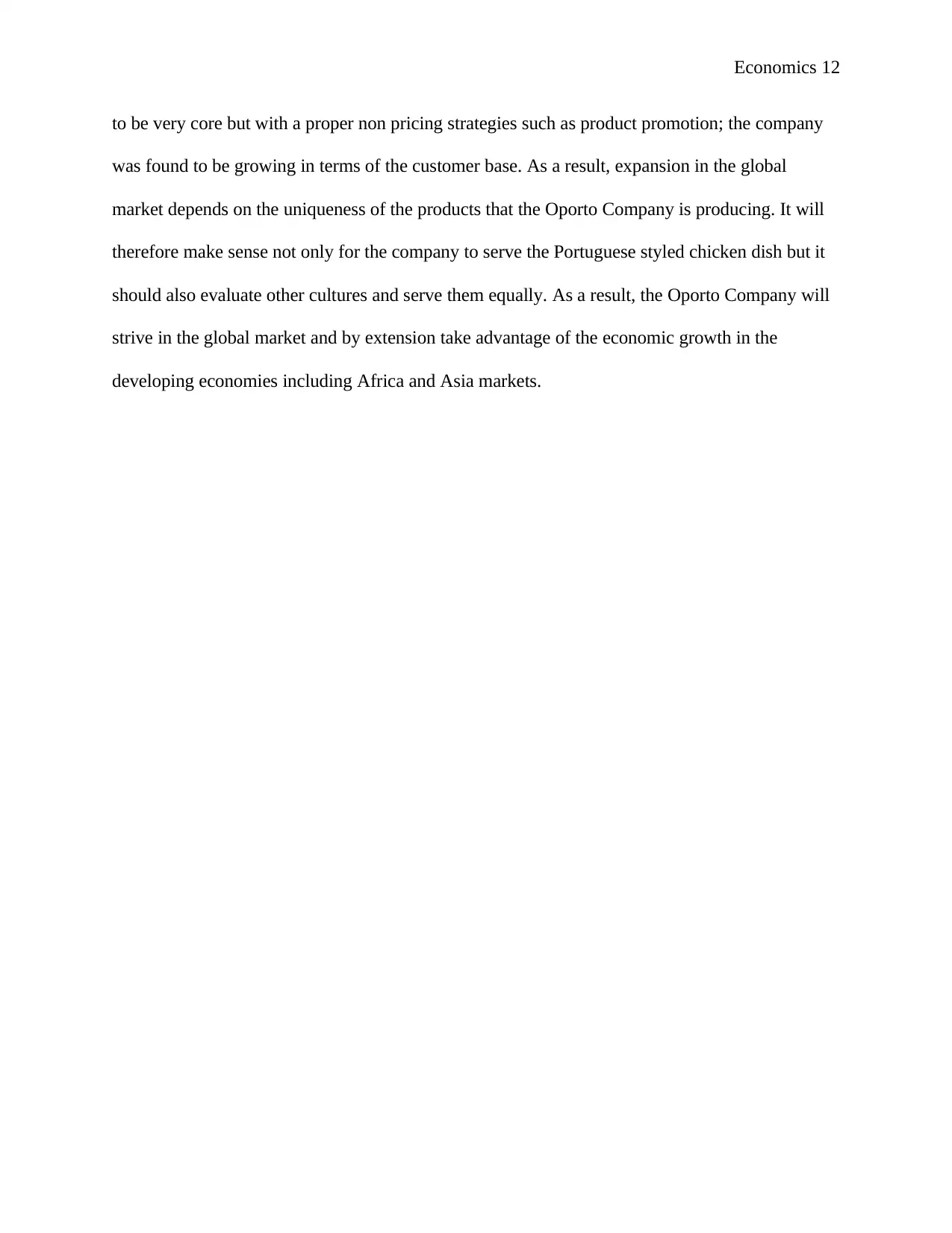
Economics 12
to be very core but with a proper non pricing strategies such as product promotion; the company
was found to be growing in terms of the customer base. As a result, expansion in the global
market depends on the uniqueness of the products that the Oporto Company is producing. It will
therefore make sense not only for the company to serve the Portuguese styled chicken dish but it
should also evaluate other cultures and serve them equally. As a result, the Oporto Company will
strive in the global market and by extension take advantage of the economic growth in the
developing economies including Africa and Asia markets.
to be very core but with a proper non pricing strategies such as product promotion; the company
was found to be growing in terms of the customer base. As a result, expansion in the global
market depends on the uniqueness of the products that the Oporto Company is producing. It will
therefore make sense not only for the company to serve the Portuguese styled chicken dish but it
should also evaluate other cultures and serve them equally. As a result, the Oporto Company will
strive in the global market and by extension take advantage of the economic growth in the
developing economies including Africa and Asia markets.
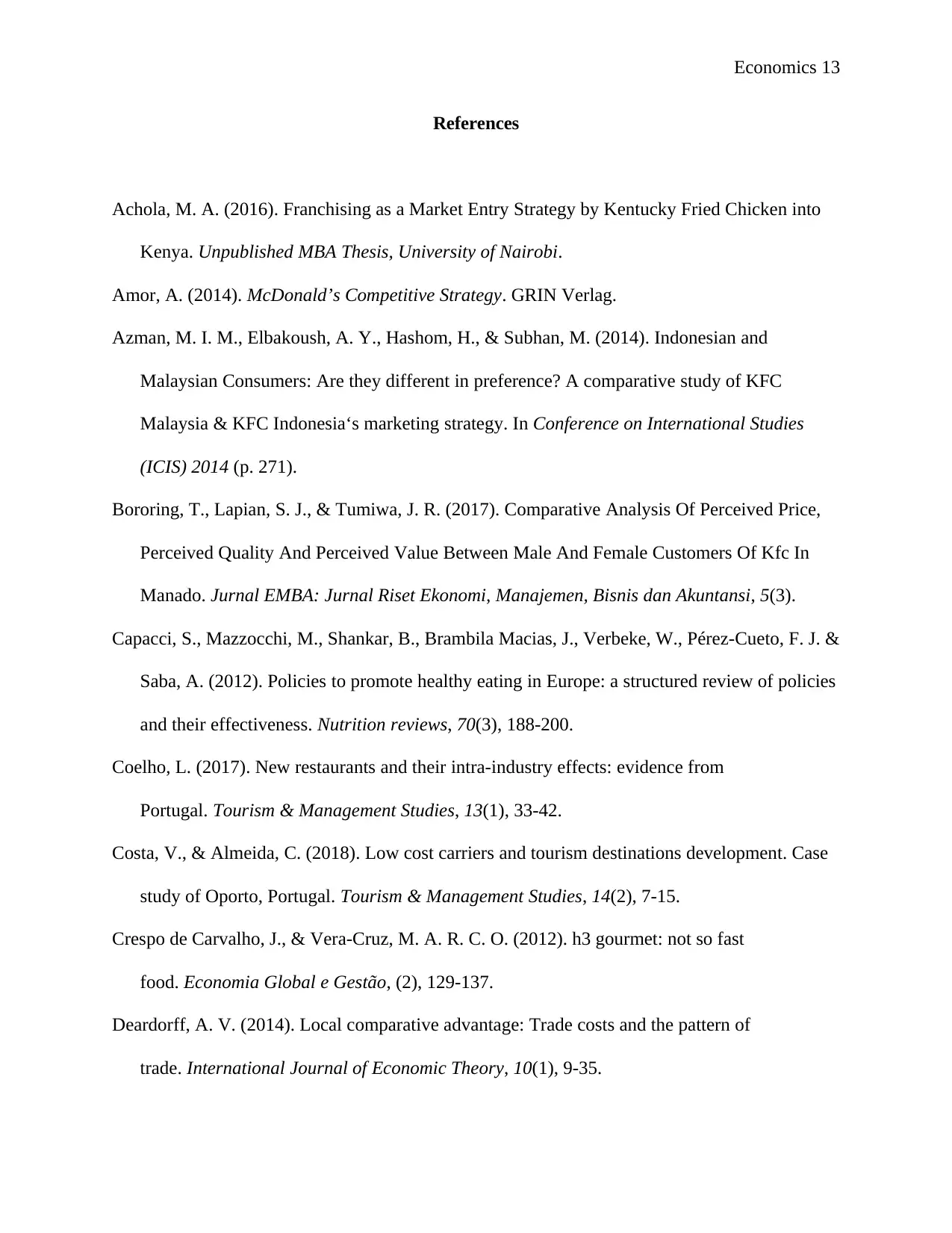
Economics 13
References
Achola, M. A. (2016). Franchising as a Market Entry Strategy by Kentucky Fried Chicken into
Kenya. Unpublished MBA Thesis, University of Nairobi.
Amor, A. (2014). McDonald’s Competitive Strategy. GRIN Verlag.
Azman, M. I. M., Elbakoush, A. Y., Hashom, H., & Subhan, M. (2014). Indonesian and
Malaysian Consumers: Are they different in preference? A comparative study of KFC
Malaysia & KFC Indonesia‘s marketing strategy. In Conference on International Studies
(ICIS) 2014 (p. 271).
Bororing, T., Lapian, S. J., & Tumiwa, J. R. (2017). Comparative Analysis Of Perceived Price,
Perceived Quality And Perceived Value Between Male And Female Customers Of Kfc In
Manado. Jurnal EMBA: Jurnal Riset Ekonomi, Manajemen, Bisnis dan Akuntansi, 5(3).
Capacci, S., Mazzocchi, M., Shankar, B., Brambila Macias, J., Verbeke, W., Pérez-Cueto, F. J. &
Saba, A. (2012). Policies to promote healthy eating in Europe: a structured review of policies
and their effectiveness. Nutrition reviews, 70(3), 188-200.
Coelho, L. (2017). New restaurants and their intra-industry effects: evidence from
Portugal. Tourism & Management Studies, 13(1), 33-42.
Costa, V., & Almeida, C. (2018). Low cost carriers and tourism destinations development. Case
study of Oporto, Portugal. Tourism & Management Studies, 14(2), 7-15.
Crespo de Carvalho, J., & Vera-Cruz, M. A. R. C. O. (2012). h3 gourmet: not so fast
food. Economia Global e Gestão, (2), 129-137.
Deardorff, A. V. (2014). Local comparative advantage: Trade costs and the pattern of
trade. International Journal of Economic Theory, 10(1), 9-35.
References
Achola, M. A. (2016). Franchising as a Market Entry Strategy by Kentucky Fried Chicken into
Kenya. Unpublished MBA Thesis, University of Nairobi.
Amor, A. (2014). McDonald’s Competitive Strategy. GRIN Verlag.
Azman, M. I. M., Elbakoush, A. Y., Hashom, H., & Subhan, M. (2014). Indonesian and
Malaysian Consumers: Are they different in preference? A comparative study of KFC
Malaysia & KFC Indonesia‘s marketing strategy. In Conference on International Studies
(ICIS) 2014 (p. 271).
Bororing, T., Lapian, S. J., & Tumiwa, J. R. (2017). Comparative Analysis Of Perceived Price,
Perceived Quality And Perceived Value Between Male And Female Customers Of Kfc In
Manado. Jurnal EMBA: Jurnal Riset Ekonomi, Manajemen, Bisnis dan Akuntansi, 5(3).
Capacci, S., Mazzocchi, M., Shankar, B., Brambila Macias, J., Verbeke, W., Pérez-Cueto, F. J. &
Saba, A. (2012). Policies to promote healthy eating in Europe: a structured review of policies
and their effectiveness. Nutrition reviews, 70(3), 188-200.
Coelho, L. (2017). New restaurants and their intra-industry effects: evidence from
Portugal. Tourism & Management Studies, 13(1), 33-42.
Costa, V., & Almeida, C. (2018). Low cost carriers and tourism destinations development. Case
study of Oporto, Portugal. Tourism & Management Studies, 14(2), 7-15.
Crespo de Carvalho, J., & Vera-Cruz, M. A. R. C. O. (2012). h3 gourmet: not so fast
food. Economia Global e Gestão, (2), 129-137.
Deardorff, A. V. (2014). Local comparative advantage: Trade costs and the pattern of
trade. International Journal of Economic Theory, 10(1), 9-35.
Paraphrase This Document
Need a fresh take? Get an instant paraphrase of this document with our AI Paraphraser
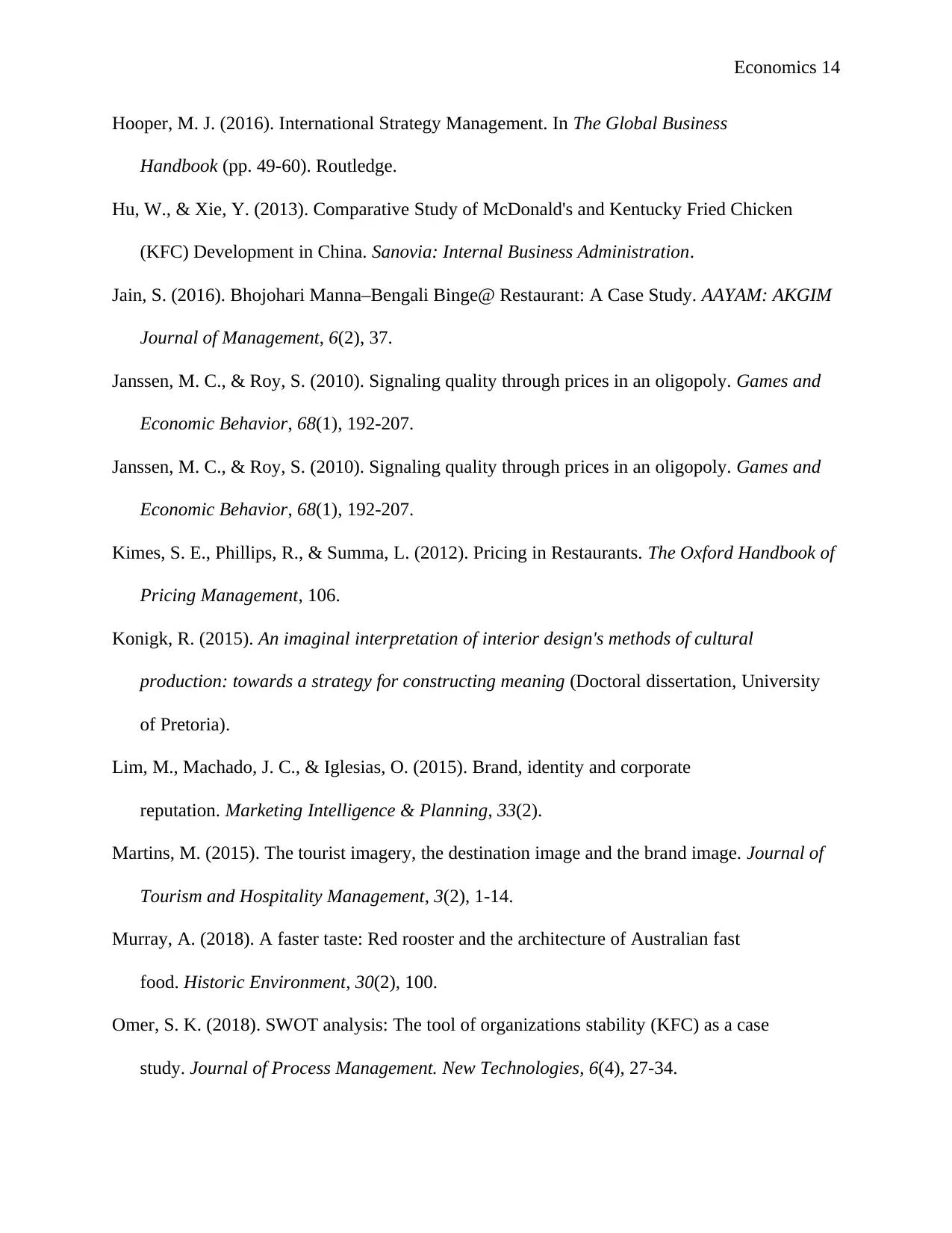
Economics 14
Hooper, M. J. (2016). International Strategy Management. In The Global Business
Handbook (pp. 49-60). Routledge.
Hu, W., & Xie, Y. (2013). Comparative Study of McDonald's and Kentucky Fried Chicken
(KFC) Development in China. Sanovia: Internal Business Administration.
Jain, S. (2016). Bhojohari Manna–Bengali Binge@ Restaurant: A Case Study. AAYAM: AKGIM
Journal of Management, 6(2), 37.
Janssen, M. C., & Roy, S. (2010). Signaling quality through prices in an oligopoly. Games and
Economic Behavior, 68(1), 192-207.
Janssen, M. C., & Roy, S. (2010). Signaling quality through prices in an oligopoly. Games and
Economic Behavior, 68(1), 192-207.
Kimes, S. E., Phillips, R., & Summa, L. (2012). Pricing in Restaurants. The Oxford Handbook of
Pricing Management, 106.
Konigk, R. (2015). An imaginal interpretation of interior design's methods of cultural
production: towards a strategy for constructing meaning (Doctoral dissertation, University
of Pretoria).
Lim, M., Machado, J. C., & Iglesias, O. (2015). Brand, identity and corporate
reputation. Marketing Intelligence & Planning, 33(2).
Martins, M. (2015). The tourist imagery, the destination image and the brand image. Journal of
Tourism and Hospitality Management, 3(2), 1-14.
Murray, A. (2018). A faster taste: Red rooster and the architecture of Australian fast
food. Historic Environment, 30(2), 100.
Omer, S. K. (2018). SWOT analysis: The tool of organizations stability (KFC) as a case
study. Journal of Process Management. New Technologies, 6(4), 27-34.
Hooper, M. J. (2016). International Strategy Management. In The Global Business
Handbook (pp. 49-60). Routledge.
Hu, W., & Xie, Y. (2013). Comparative Study of McDonald's and Kentucky Fried Chicken
(KFC) Development in China. Sanovia: Internal Business Administration.
Jain, S. (2016). Bhojohari Manna–Bengali Binge@ Restaurant: A Case Study. AAYAM: AKGIM
Journal of Management, 6(2), 37.
Janssen, M. C., & Roy, S. (2010). Signaling quality through prices in an oligopoly. Games and
Economic Behavior, 68(1), 192-207.
Janssen, M. C., & Roy, S. (2010). Signaling quality through prices in an oligopoly. Games and
Economic Behavior, 68(1), 192-207.
Kimes, S. E., Phillips, R., & Summa, L. (2012). Pricing in Restaurants. The Oxford Handbook of
Pricing Management, 106.
Konigk, R. (2015). An imaginal interpretation of interior design's methods of cultural
production: towards a strategy for constructing meaning (Doctoral dissertation, University
of Pretoria).
Lim, M., Machado, J. C., & Iglesias, O. (2015). Brand, identity and corporate
reputation. Marketing Intelligence & Planning, 33(2).
Martins, M. (2015). The tourist imagery, the destination image and the brand image. Journal of
Tourism and Hospitality Management, 3(2), 1-14.
Murray, A. (2018). A faster taste: Red rooster and the architecture of Australian fast
food. Historic Environment, 30(2), 100.
Omer, S. K. (2018). SWOT analysis: The tool of organizations stability (KFC) as a case
study. Journal of Process Management. New Technologies, 6(4), 27-34.
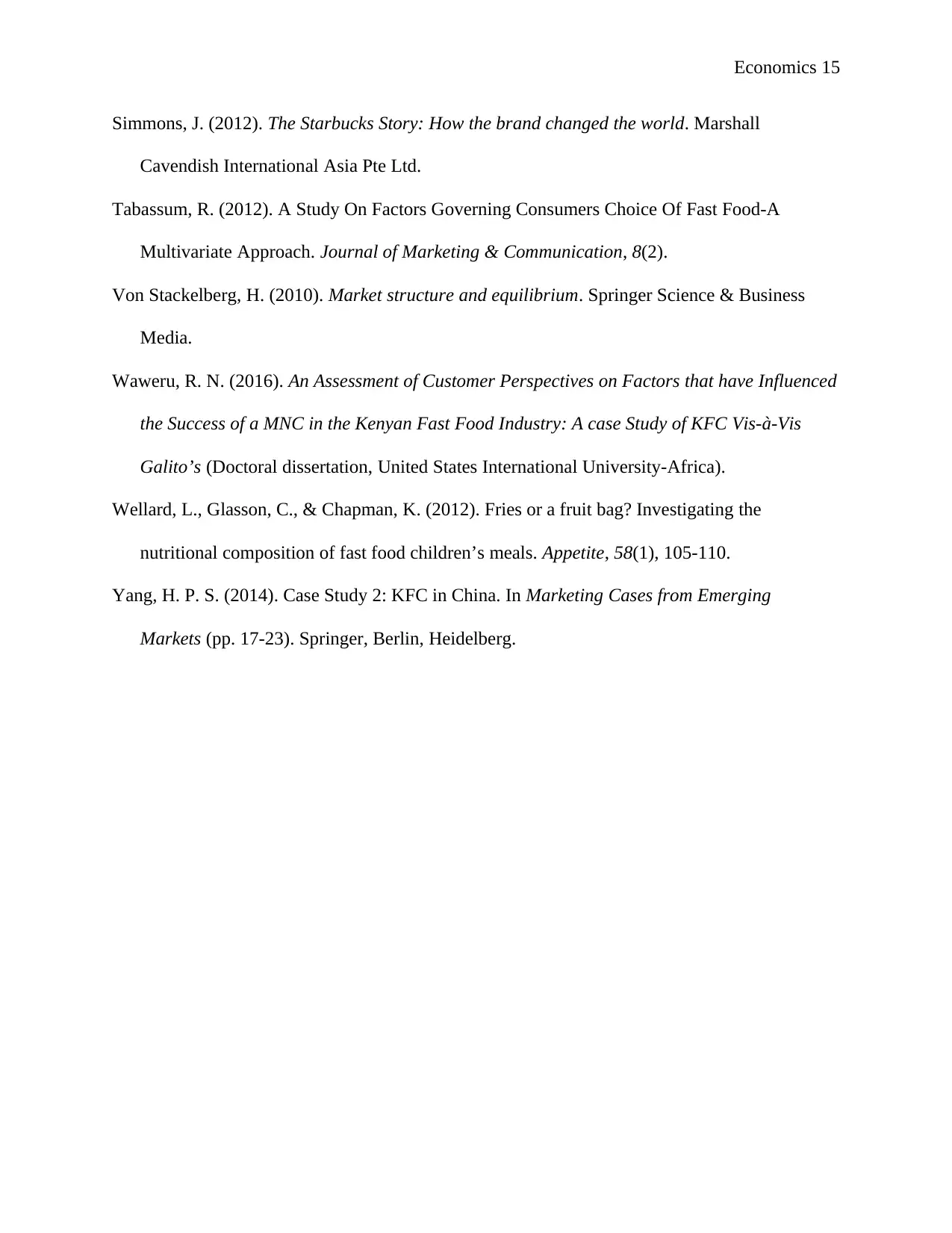
Economics 15
Simmons, J. (2012). The Starbucks Story: How the brand changed the world. Marshall
Cavendish International Asia Pte Ltd.
Tabassum, R. (2012). A Study On Factors Governing Consumers Choice Of Fast Food-A
Multivariate Approach. Journal of Marketing & Communication, 8(2).
Von Stackelberg, H. (2010). Market structure and equilibrium. Springer Science & Business
Media.
Waweru, R. N. (2016). An Assessment of Customer Perspectives on Factors that have Influenced
the Success of a MNC in the Kenyan Fast Food Industry: A case Study of KFC Vis-à-Vis
Galito’s (Doctoral dissertation, United States International University-Africa).
Wellard, L., Glasson, C., & Chapman, K. (2012). Fries or a fruit bag? Investigating the
nutritional composition of fast food children’s meals. Appetite, 58(1), 105-110.
Yang, H. P. S. (2014). Case Study 2: KFC in China. In Marketing Cases from Emerging
Markets (pp. 17-23). Springer, Berlin, Heidelberg.
Simmons, J. (2012). The Starbucks Story: How the brand changed the world. Marshall
Cavendish International Asia Pte Ltd.
Tabassum, R. (2012). A Study On Factors Governing Consumers Choice Of Fast Food-A
Multivariate Approach. Journal of Marketing & Communication, 8(2).
Von Stackelberg, H. (2010). Market structure and equilibrium. Springer Science & Business
Media.
Waweru, R. N. (2016). An Assessment of Customer Perspectives on Factors that have Influenced
the Success of a MNC in the Kenyan Fast Food Industry: A case Study of KFC Vis-à-Vis
Galito’s (Doctoral dissertation, United States International University-Africa).
Wellard, L., Glasson, C., & Chapman, K. (2012). Fries or a fruit bag? Investigating the
nutritional composition of fast food children’s meals. Appetite, 58(1), 105-110.
Yang, H. P. S. (2014). Case Study 2: KFC in China. In Marketing Cases from Emerging
Markets (pp. 17-23). Springer, Berlin, Heidelberg.
1 out of 15
Related Documents
Your All-in-One AI-Powered Toolkit for Academic Success.
+13062052269
info@desklib.com
Available 24*7 on WhatsApp / Email
![[object Object]](/_next/static/media/star-bottom.7253800d.svg)
Unlock your academic potential
© 2024 | Zucol Services PVT LTD | All rights reserved.





